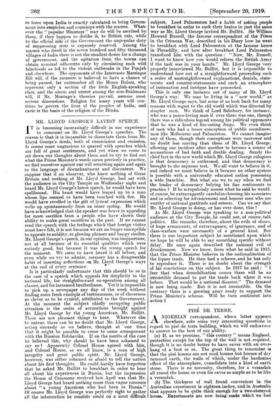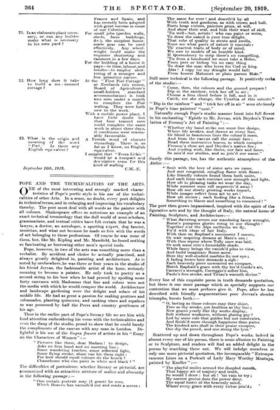PISA DE TERRE.
ANIGERIAN correspondent, whose letter appears elsewhere, asks some very interesting questions in regard to piss de terse building, which we will endeavour to answer to the best of our ability.
(a) If, as we presume, " this country " means England, protection except for the top of the wall is not required, though it is no doubt better to have eaves with an over- hang of a foot or so. The great thing to remember is that the.piss louses are not mud houses but houses of dry rammed earth, the walls of which, under the hardening!, effect of the atmosphere, consolidate into a kind of earth stone. There is no necessity, therefore, for a verandah all round the house or even-for eaves so ample as to be like a verandah.
(b) The thickness of wall found convenient in the Australian experiment is- eighteen-inches, and in Australia that appears to be quite thick enough fora two-storeyed house. Experiments are now being.snad.e which we feel sure will prove that.an- eighteen-inch wall is amply suffi- cient for-buildings of several storeys in this country. (0) The Australian Settler's Handbook, following the French XVIllth century books, declares that all earths are suitable for pise work,• except pure clay or pure sand. In other words, all ordinary learns are suitable, and where sand and clay can be mixed they make a very good wall.
We are much interested in what our correspondent says in regard to Dutch barn-roofs. No doubt there is a great opportunity for anyone who will invent or revive some cheap .form of roofing. Unfortunately, thatching is becoming a lost art and is . also very expensive ; tiles, like bricks, are also prohibitive in price for any building - which is designed to be cheap, and the same happily applies to that most ugly and " hot-and-cold " form of roofing- provided by corrugated iron. Rubberoid and other felts make excellent flat roofs, but require a great deal of timber, and timber is now one of the dearest of building materials. If it were not, flat rammed earth roofs, tarred like our roads, might prove practicable. Peat or ordinary turves placed over corrugated iron make a very warm and cool roof, and the hideousness of the corrugated iron is thus disguised. But till corrugated iron becomes cheap again this cannot, as we have said, be regarded as an inexpensive method of roofing.
We may add a few general observations in regard to pise building. In the British climate, both for appearance and for the general preservation of the wall, plastering outside is to be recommended, though an unplastered pise back wall in a cartshed erected at Newlands Corner has withstood four very wet and frosty winters without an overhang. The walls of this shed have tended .to grow harder until they are now almost like weathered sandstone, tad inside the wall is always dry. Ordinary lime plaster lakes as firm a hold of the earth as whitewash and rough- last do in the ease of the old cob buildings of Devon- shire and Cornwall. It should be remembered always, however, that cob is not pig. Cob is clay and:shale put op wet and mixed with. straw ; pise is earth put up dry ind without admixture, and consolidated by hard ramming between boards.
Another good thing to remember is that pise is not a patent of the Spectator or of anybody else. As Pliny re- marked nearly 2,000 years ago, it is a very old and well-tried system of building. His definition of pise, or, as he calls it, formacean* walls, as " earth rammed hard between boards," given in the VIth Book of the Natural History, remains the best definition as also the most interesting. He notes that neither frost nor heat nor cold has any affect on the walls, which indeed are so imperishable that watch towers built by Hannibal on the tops of the hills in Spain remain to this day. There are, of course, prehistoric - pise buildings in New Mexico and Arizona which are said to be at least 4,000 years old.
We will summarize what we have written by printing a number of technical questions asked us by correspondents with the answers given by Mr. Williams-Ellis, to whom the interrogatories were submitted.
We may mention once again-that any enquiries by our readers -about the pise cottage at Newlands or in regard to pise,generally should be addressed not to the Spectator or to Mr. Strachey, but direct to the architect, Mr. Clough Williams-Ellis, 14 Queen Anne's Gate, S.W.
Prehistoric examples still existing, possibly over three thousand years old (S. America).
I know -numerous examples of cob houses three and four hundred years old in this country, and Pisa is, I consider, a better material, both mechanic- ally and chemically.
If summer-built, immediately after tompletion.
18', 14', 12'. No cavity.
Yes.
• Weavish some scholar-reader of the Sar,teor would give us the derivation of the word " formacean."
1. Approximate life of house after erection on Pisa System ?
2. -How soon after erection can house be occupied ? 3. Thickness of outer walls, and is there a cavity in same between outer facing and inside lining ? 4. Around fireplaces, will brick- work be used ? No. Too dense.
Shutteriug is removed and re-erected on the just- completed .wall, and the process repeated over and over again with the same shuttering as fast as you please. You " ram till it rings." It is immediately removed. Consequently it is possible to build continuously with one pair of shutter boards.
No. Timber in old Continental examples is found as clean and fresh as - when inserted.
Yes.
Or colour-washed on the Pisa direct if walls well and truly made.
Mixed lime and cement render- ing, or hot tar spray, with whitewash a week later.
Walls four years old at New- lands, without any exterior treatment what- ever, are getting harder each year. Piss reinforced over -wider spans with sticks or scrap metal.
Eminently. No cartage, rough labour, non - conducting, exceeding cheapness.
First time point has been raised. Earth is, of course, one of the best fire- extinguishers, but a com- pletelDurn-out might crack the,walls, though I should imagine lees than in a brick or stone building.
I will certainly try the effect of fire on.an experimental wall. I will also get an insurance surveyor-t0 look at the house now in process of building.
Apparently any kind bar real clay or almost pure sand. First is apt to crack when used in large masses, . and latter too little co- hesion to ensure stability. Stones over, say, the size of a champagne cork, should be excluded ; also any vegetable matter, such as roots.
No, nothing whatever, not even water.
No. Pia) blocks 9' by 9' by 18' used for piers and par- titions only. The main walls are 18' thick, mono- lithic and homogeneous, and without jointe, either horizontally or vertically. No. Such openings are left to the exact sizes required as the work proceeds by inserting .adj u s t ab I e ' stops " in the shuttering.
No ; though these were of an unusually inexpensive nature.
There is no Patent or secret about Flee building ; it is, indeed, the simplest method of building imaginable, and, so far as the country is con- cerned, of almost univer- sal application.
Somewhat crudely executed with primitive and cumbersome plant, it has long been practised in certain provinces of
5. Will mice, rats, or other vermin be able to harbour easily in these walls ?
6. I take it temporary sheeting will be erected to retain the earth.
What amount of punning is necessary to give the wall the required solidity ?
7. How long has Sheeting to remain up after earth is filled in and punned ?
8. Where timbers rest on walls, is there any fear of rot being set up ?
9. I take it the usual damp course will be necessary ? 10. Are walls plastered inter- nally in the ordinary way ?
11. How do you advise the outside of walls being treated 7
12. What do you recommend over the door and window openings ? Wood lintels, or is the Pisa earth sufficient ?
13. Is the system suitable for cart sheds, stables, and other farm buildings ?
14. Will the Insurance. Com- panies want higher rates to cover fire risks 16. Any special kind of earth required ?
Should stone, sand, and clay be - excluded ?
10. Do you mix anything with the earth to make it bind ? I notioed that the older Ilse walls at New- lands Corner rang like stone.
17. Some accounts describe the Newlands Cottage as built of earth blocks laid in mortar. Is this correct ?
18. Are the window and door openings cut out after the completion of the -walls ?
19. Did the cost of £20 given for the complete Pise outer walls of the six- roomed cottage include foundations and damp course ?
20. Is there any " Patent " about Pisa building, or is it an ancient method revived and improved ? France and Spain, and has recently been adopted with great success in some of our Colonies.
For small jobs (garden walls, sheds, farm buildings, &c.), the simplest home- made gear can be used effectively. Any wheel- wright could make the requisite shuttering and rammers in a few days.
For the building of a house it pays—in time, labour, and results—to employ shut- tering of a stronger and lees primitive nature. 22. How long does it take At the " First Pise Cottage " to build a six - roomed at Newlands (six rooms, cottage ? Board of Agriculture's small-holders standard accommodation) it took two men under a month to complete the Piss walling. They were both new to the work.
With a mobile power plant, I have little doubt but that four trained men could complete the same work in about three days, if conditions were reason- ably favourable.
A French word of obscure etymology. Thera is, so far as I know, no English equivalent.
I suggest that "Terra-Lithic " would be a compact and des Iriptive term fir this kind of walling
21. Is an elaborate plant neces- sary, or can any builder make what is necessary in his own yard 21 What is the origin and meaning cf the word "rise.," Is there any English .equ:valent ?








































 Previous page
Previous page